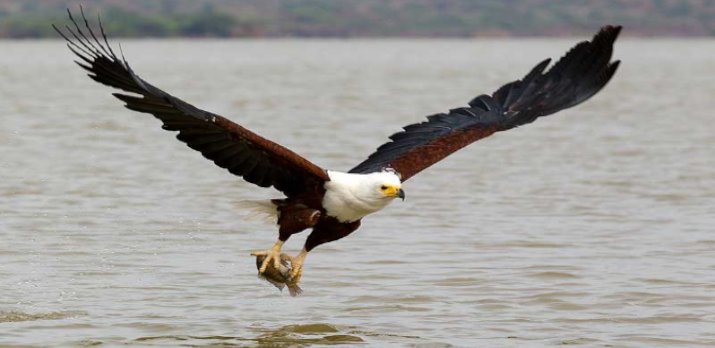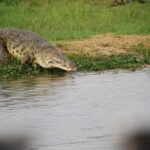The African fish eagle / Haliaeetus vocifer is a large species of eagle found throughout sub-Saharan Africa. It has a distinctive black, brown, and white plumage. African fish eagles are quite common and can be found near rivers, lakes with an abundant food supply occur.
The African fish eagle is 73cm in height with the female being slightly larger than the male at 3.2 and 2.5 respectively. Males usually have wingspans around 2m, while females have wingspans of 2.4m.
Adult birds have a gleaming white breast, tail, throat and head with the exception of the featherless face while the shoulders and under parts are chestnut; the back and the wings are black. The juvenile birds are scruffy, largely dark brown with a dark cap and whitish face and variable line on the nape, throat and breast. The under wings have white patches. The African fish eagle attains full plumage in the fifth year.

African Fish Eagles eat a wide variety of fish and they don’t submerge themselves completely under the water when fishing, instead they catch their meals from the surface of the water, then fly up to a perch to feed. Its feet have rough soles and are equipped with powerful talons to enable the eagle to grasp slippery aquatic prey. The African Fish Eagle is opportunistic and may take a wider variety of prey such as small water birds and insects other than fish during dry periods when water levels are low. They also attack larger birds such as Greater and Lesser Flamingos and even feed on carrion. It’s also classified as a kleptoparasite (it steals prey from other birds) such as the Goliath Herons which are known to lose a percentage of their catch to Fish Eagles.
African Fish Eagles build large nests out of sticks and branches, usually in a tree the nests are usually heavy as well. That is why big, strong trees capable of supporting huge nests are important to breeding pairs of eagles. A pair uses the same nest year after year, each year adding new nesting material to the existing structure and the nests can become quite large. Some nests have measured 6 feet long and 4 feet deep.
The female lays 1-4 eggs, but usually just two. Incubation is mainly the female’s job. For about 45 days, she spends most of her time sitting on her eggs to keep them at a safe temperature. Occasionally, she carefully turns the eggs with her beak to make sure they are warmed evenly. She only leaves the nest to stretch, clean her feathers, and eat. Once the chicks hatch, the female continues her role as the primary caregiver to her young. She is responsible for feeding her nestlings, while it is the male’s job to go out and find food for himself and his family. The young remain in the nest for about 70-75 days before they fledge, or fly for the first time. Once the young are flying around, they will remain close to the nest for two or three months before dispersing.
In a few years, these young birds will find a territory and a mate and begin raising young on their own. Scientists believe that African Fish Eagles mate for life
So well-known and clear is the call of this bird that it is often known as “the Voice of Africa” with atypical loud barking and distinctive which is made by males. The call is a weee-ah, hyo-hyo in flight and when near the nest its call is more of a ‘quock’ sound – the female is a little shriller and less mellow than the male.
Did you know?
Just like the Osprey, the African Fish Eagle has barbs called spiricules on its feet to help it hold on to slippery fish, its main prey.










